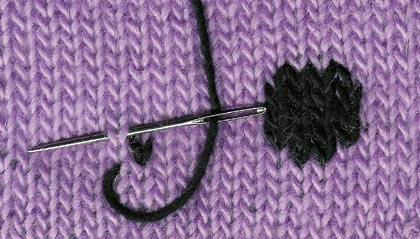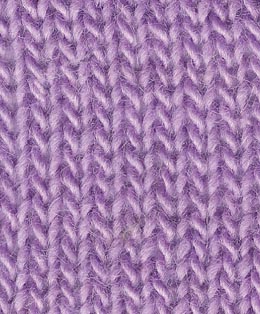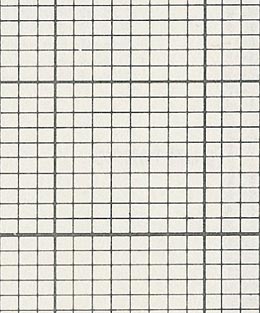| 16: Embroidery or
Decoration After finishing the
knitted pieces, you may wish to add embroidery or some other
feature or decoration. Itís easier to do this before you join the
garment seams. For one thing, you will have less fabric to hold and
you can attack the piece from any angle or side. If, for some
reason, you have to do some joining, leave openings to allow you to
manoeuvre the needle and thread.
If you are doing some exotic embroidery, you
are obviously much better at embroidery than me, so you will know
what you have to do. You are the expert here.
---
Swiss darning, or duplicate stitch
My favourite embroidery for knitwear is
duplicate stitch or Swiss darning stitch. This stitch is charted as
a graph, and follows the thread of the stitch below and looks as if
the design has been knitted in to the fabric. It is easy to use from
the simplest design to the most complex [pic 1].

1: Swiss darning (or duplicate
stitch) follows the path of the underlying knitting stitches.
Work with a blunt wool embroidery needle so
that you do not split the base stitches. Use a sharp, large-eyed
needle to sew in all the ends on the wrong side. It seems to be
faster if you sew in the ends as you go, instead of leaving them to
do all in one hit.
Embroidery on knitwear is made easy because the knitted stitches are
a grid. Placing matching motifs on different pieces, shaping curves,
straight lines, adding leaves to flowers, or whatever you decide to
work is simplified when you position the decoration by counting the
stitches and rows.
Because knitting stitches form a grid, they equal a graph. It is a
simple matter to use cross stitch designs, or use graph paper to
design your own motifs.
If you are using a design from a square graph, remember that because
stitches are wider than they are high, the finished result will look
squat unless you repeat or add rows to keep the proportion correct.
I always remember a beloved pink jumper made as a gift for my
daughter. It featured a ballerina, worked from a cross stitch
embroidery graph, with short fat legs and hefty shoulders. The
square graph factor hadnít been allowed for.
You can find graph paper which has been printed using a rectangular
grid rather the normal squares. The proportion is usually eight
stitches to ten rows. Look at some graph designs in knitting books,
and youíll see that they have usually been designed on this kind of
graph [pic 2,3].


2 (left) and 3 (right) :
Knitted stitches relate perfectly to graphs, but as stitches are
rectangular, you must either find a suitably proportioned graph
(example at right) or make allowances for square graphs.
To give you a wider choice of design, you
can convert square graph or cross stitch patterns very easily by
repeating every fourth row. To make it easy, mark the repeat rows on
the graph.
NEXT PAGE >>
chapter page: 1 | 2 |